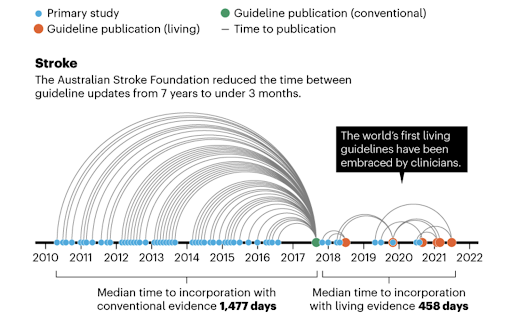How Covidence has enabled living guidelines for Australians impacted by stroke
Background
At the age of 27, Stacey Grapsas had a stroke. It was the scariest moment of her life. Fortunately, she has made an almost complete recovery. Stacey is one of nearly 15 million people living with the effects of stroke. With the lives of people like Stacey at stake, the Stroke Foundation of Australia realizes how crucial it is that practitioners have access to the latest research evidence to guide their care.
The Australian and New Zealand ‘Clinical Guidelines for Stroke Management’ guides the care of people with stroke. Until recently, working with traditional systems, the Stroke Foundation has only been able to update this critical resource every 5-7 years. In the large gaps between updates, practitioners had been left to their own devices to collate the often rapidly evolving evidence into clinical practice.
Key Takeaways
Clinical guidelines took 7 years to update prior to moving to a living evidence approach
Covidence streamlined workflows and created real time savings for the guidelines team
Using Covidence to move to living guidelines, Stroke Foundation Australia has increased the trust, currency and use of clinical guidelines
The Solution
In 2018, in collaboration with Cochrane Australia, Covidence and the MAGIC platform the Foundation embarked on an innovative project to accelerate the translation of research into the national stroke clinical guidelines. They used a process termed ‘Living Evidence’ in which the guidelines are kept constantly up to date with the latest research. With the aid of technology, the Foundation reduced the time between guideline updates from 7 years to under 3 months, creating the world’s first living guidelines.

“As the peak body for stroke in Australia, we use evidence to advocate for policy change, reducing the time from “bench to bedside” so that the investment in medical research can be realized faster.”
Sharon McGowan, CEO Stroke Foundation of Australia

Covidence for collaboration, project management and efficiency
The 100 strong team of clinicians and staff at the Foundation could not undertake this work without Covidence. Covidence is their evidence ‘home’, where their references, decisions and discussions are all in one place. Using Covidence has saved the team many hours of work.
Building trust while updating frequently
However it’s not only efficiency gains. Priding itself on being an evidence-based organization, committing to frequent ‘living’ updates has only been possible for the Stroke Foundation because Covidence has enabled the rapid updating without reducing the methodological quality of their systematic review processes.
“In a fast moving field of research the Stroke Foundation relies on Covidence to efficiently coordinate reviewing global evidence. This streamlined systematic review process powers our living guideline recommendations and ensures that clinicians working in stroke in Australia have evidence-based, actionable guidance in their hands anytime, anywhere. This is a partnership which benefits every Australian impacted by stroke.” said Sharon McGowan, CEO The Stroke Foundation of Australia.
Core benefits
Workflow efficiency. Trustworthy guidelines. Better health outcomes

“Covidence has simplified our workflow and saved countless hours during the screening process. The team is always super responsive and helpful and great to work with. We hope to use more of the functionality of Covidence in the future. Recommend the product!”
Kelvin Hill
Manager, National Manager, Clinical Services at National Stroke Foundation
By using Covidence, to adapt and accelerate their processes, the Foundation has become a world leader in providing accessible, evidence-based and actionable guidance for every clinician caring for people with stroke.
Covidence is now being used by many other guideline organizations to develop and update their guidelines, using either conventional or living approaches.
If you would like to learn more about how Covidence can support your organization to create world-leading evidence and guidelines, please contact us at support@covidence.org
Covidence is used by world-leading evidence organizations



